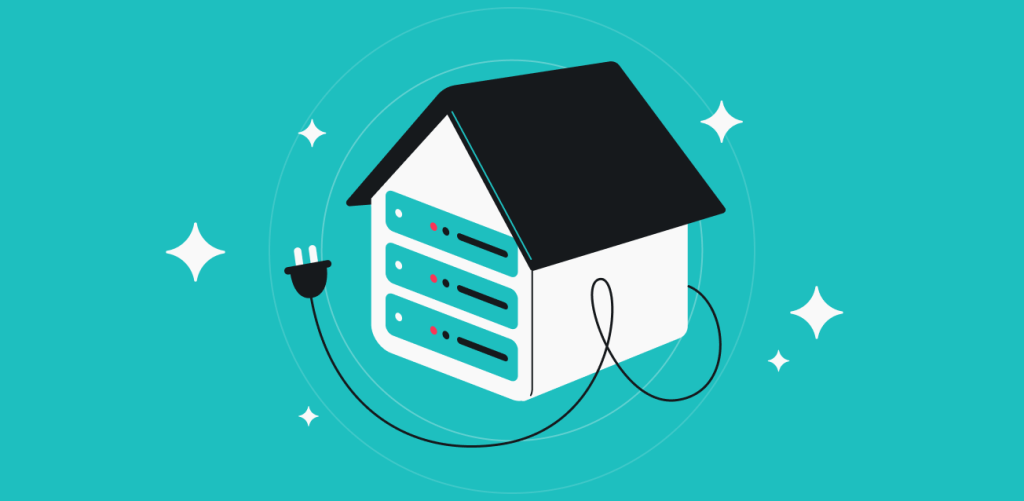
A home server can be handy for a myriad of reasons. And the setup process itself is loads of fun as long as you’re up for the challenge. Basic tech knowledge and a limited budget can take you a long way in the world of home servers, and I am here to tell you all you need to know before you get started.
Table of contents
What is a home server?
Home servers allow your devices to communicate and share files with each other. It can be anything from a fancy yet costly, high-end server to an old computer that acts as a central location to store all your data.
Usually, people store their files on one device and have to share them with other devices, which wastes time and space. With a home server, all devices have access to the files stored on the server when connected to your home network. This makes working from home easier if you’re using several devices on your local network.
Example: let’s say you have a file on your laptop that you need on your home computer. Without a home server, you would need to go through the time-consuming process of transferring the file. In contrast, you can use any device to access files that are stored on the home server without having to transfer anything.
The benefits of having a home server
The benefits of having a home server are not limited to convenient file sharing. It can help with home automation, the performance of your devices, online security, and more. Let’s take a look at the key perks of home servers.
-
Share files easier
Since the server is connected to your home network, anyone in your family can use their own devices to access and play the media in real-time. So the next time your mother asks for a photo of her standing beside a big rock from a family vacation in 2009, tell her to go to the home server. Just remember to put it all on the server in the first place.
-
Consume less power on your device
Playing media consumes a large amount of power on your computer. The more your device has to run, the slower it becomes.
Let’s say you want to work on your laptop while watching a movie in the background. You can play a movie on your laptop’s screen but use the power of the home server. That way, you enjoy the best of both worlds without the risk of your computer slowing down or crashing.
-
Back up your data
The data on your device is never truly safe. Clicking a malicious link once, or even something as basic as spilling a hot drink over your computer, can result in loss of valuable information. That’s why it’s critical to back up all of your data regularly.
A home server can act as a backup server for your house. You can set it up to back your data up automatically and store files from all devices, or you can transfer any data to the home server yourself whenever you want.
-
Set up home automation and security
Since your home server connects to all your devices, it is the perfect centralized platform to manage your smart home from. You can manage heating, lighting, or home appliances through it and optimize energy saving, or you can use it as a control panel for all your home security systems.
-
Host your own website
Having your own home server offers a good alternative to web hosting. It would not be able to handle large amounts of traffic, but it’s a great option for simple websites with a limited user base, such as personal blogs.
Not only is it convenient to have everything stored securely on a private server, it may actually end up being cheaper than buying web hosting services in the long run.
-
Set up a proxy server
You can set up your home server to act as a proxy server and route your internet traffic through it. That being said, proxy servers don’t offer the privacy or security of a VPN. So even if you do decide to use a proxy server, you should consider using a VPN together with it as well.
-
Enhance your gaming experience
You can run multiplayer games from your own server instead of using the one offered by game developers. Since the game is hosted on your home server, you should experience better performance and fewer connectivity issues. On top of that, you can customize the game to your liking as well.
What equipment do you need to set up a home server?
Contrary to popular belief, setting up a home server does not have to be expensive or difficult. In fact, you probably have at least some, if not all, of the things needed to get started. And even if you don’t, a basic server build won’t set you back more than a few hundred dollars. Here’s everything you need:
- Computer or server;
- Internet connection;
- Network router;
- Ethernet (CAT5) cable.
How to set up a home server
The complexity of the setup depends on what you’re going to use it for. Each of the server functions mentioned above may require different configurations and even different hardware. That being said, the following three steps apply to all home server builds, no matter what you’re going to use the server for.
Step 1. Get the hardware
You can repurpose an old computer you no longer use. It doesn’t have to be powerful, so don’t be afraid to use an older machine. Some old devices may need minor hardware upgrades, but you can get used parts in most cases, so you definitely won’t be breaking the bank.
Even if you don’t have an old computer to repurpose, you can get a used desktop computer or a budget home server for less than a few hundred dollars. If you really want to turn it into a project, you can buy parts and build the whole thing from scratch, but it can be a bit more costly than getting a used computer to act as a home server.
Step 2. Choose the operating system
There are loads of OS (Operating Systems) to choose from for a home server. If you used Windows all your life and don’t feel like changing, go ahead and use Windows. Just bear in mind Windows OS isn’t free, while Linux and Ubuntu are, and both are great free alternatives for all-around use.
On top of that, there are free operating systems that may be a perfect fit for specific applications. For example, FreeNAS is great for getting the whole family involved, while Unraid may just be the best choice for gamers.
Step 3. Start setting up
The setup process for your own home server can be vastly different depending on the operating system and how you intend to use it. There are too many options to count, so you will need to do your own digging once you figure out what you’re going for. Then again, it wouldn’t be a good project if you didn’t need to do a little bit of research on your own.
Time to build a server at home
Building your own server is a great first project if you’re interested in tech. It’s relatively easy, affordable, and actually useful.
Home servers are a great way to ensure your files are backed up, and you won’t need to worry about losing them if your other devices break. Managing your smart home becomes a lot easier as well. So don’t hesitate — start building a server today! But if you merely wanted a VPN for your home, Surfshark is a good choice.
FAQ
What is a home server used for?
Storage and file sharing are the main uses for home servers. But they can also be used for home automation, hosting websites, increasing the performance of your computer, and even for gaming.
Do home servers need a lot of RAM?
The amount of RAM you need for a home server depends on the tasks that you’re going to perform on it. Some may run just fine with 4GB of RAM, and you should be more than set with 8GB for basic applications.
Is a home server expensive?
Servers can get pretty expensive if you want the best, most powerful thing out there. However, basic home servers can cost next to nothing, since you can reuse your old computer to set it up.

